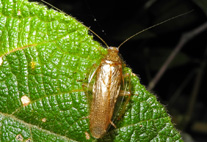Abstract
Two new species of nematodes belonging to the family Cephalobidae (Nematoda, Rhabditida) are described from natural areas in the province of Kerman, Iran. Paracrobeles deserticola sp. n. is characterized by its body length of 0.48–0.60 mm in females and 0.47–0.66 mm in males, cuticle annulated and weakly tessellated into rectangular blocks with striae discontinuous across annulations, lateral field with two wings, areolated, separated by a narrow groove, lip region slightly offset, 15–20 μm wide, lips asymmetrical with two long seta-like processes arising from its margin, primary axils bearing one triangular-elongate guard process, secondary axils with two setiform guard processes with one originating from each lip, labial probolae bifurcated with long and smooth prongs having a small basal ridge, stoma 11–14 μm long, metacorpus swollen, spermatheca 33–50 μm long, post-uterine sac 60–96 μm long or 2.9–4.5 times the corresponding body diameter, vulva located slightly posterior to mid-body length (V = 50–63), female tail conical with finely rounded tip (53–67 μm, c = 9.0–10.0, c’ = 2.0–3.0), male tail conical and curved ventrad with finely rounded tip (48–54 μm, c = 9.0–13.0, c’ = 1.8–2.0), spicules 46–56 μm long and curved ventrad, and gubernaculum 16–24 μm long. Nothacrobeles hebetocaudatus sp. n. is characterized by its body length (0.42–0.51 μm in females and 0.42–0.52 µm in males), “single” cuticle, lateral field with three incisures, asymmetrical lips divided in two sections at level of the labial papilla, each lip with four tines along its margin, primary axils deep bearing one triangular-elongate guard process originating from the incomplete first annulus, secondary axils demarcated by narrow incisures separating the lips of the pair and without guard processes, labial probolae bifurcated and without tines (7–11 μm long), pharyngeal corpus 2.0–3.7 times isthmus length, Rex = 28–38, spermatheca 24–55 μm long or 2.9–3.8 times the corresponding body diameter, post-uterine sac 18–27 μm long or 0.7–1.3 times the corresponding body diameter long, female tail conical with rounded terminus (30–36 μm, c = 13.6–15.5, c' = 1.8–2.3), phasmid at 38–44% of tail length, male tail conical (28–40 µm, c = 11.5–15.3, c' = 1.7–2.0), spicules 20–25 µm long and gubernaculum 11–16 µm long. Descriptions, measurements, illustrations and SEM pictures are provided for these two species. In addition, SEM study of N. abolafiai is presented. Molecular analysis based on 28S rDNA (D2/D3 expansion fragments) places Paracrobeles deserticola sp. n. in a clade together with N. abolafiai and N. hebetocaudatus sp. n., while other species of the genus Nothacrobeles (N. borregi, N. spatulatus and N. tringlarus) are all placed in separate clades. The results suggest that the genus Nothacrobeles might be a polyphyletic taxon.

